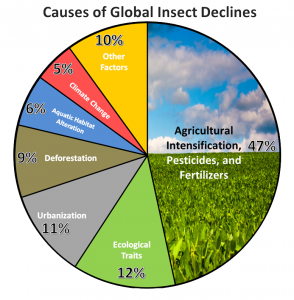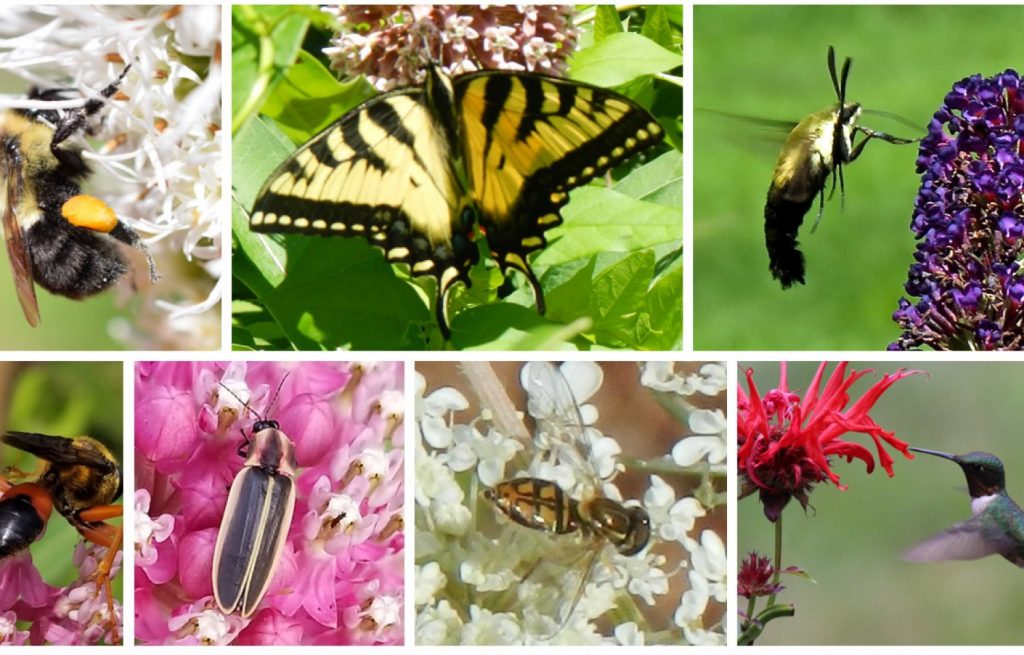A consortium of environmental groups are urging EU policy makers to do more to protect declining insect populations as part of the European “Green Deal.”
As ABC news has reported , the EU’s sweeping climate proposal seeks to make Europe “the first climate-neutral continent.” It calls for, among other things, several major ag and land use policy changes that are viewed as necessary in order to achieve net-zero greenhouse gas emissions by 2050:
- Cut the use of chemical pesticides by half by 2030
- Reserve 25% of the farmland in the EU for organic farming (it’s now only 8%, but growing fast)
- Plant 3 billion trees over 10 years
But groups like Friends of the Earth Europe argue that these provisions don’t go far enough to protect declining insect populations. Research shows that up to 75% of historic insect populations have been lost, and today at least 1 in 10 bee and butterfly species on the continent are facing extinction.

We’ve reported many times on the huge share of agricultural production worldwide that is reliant on insect pollinators, and especially production of nutrient-dense fruit and vegetable crops so essential to good health.
This is surely the case in Europe –“according to figures released by the European Parliament, about 84% of crop species and 78% of wildflowers across the EU depend to some extent on animal pollination” (Petrequin, 2020).
European insect advocates believe that pesticide use is largely responsible for declining insect populations, and the accompanying threat to food security. They are campaigning for legislation that would take more “drastic” action and cut pesticide use by 80% by 2030. EU-wide legislation to achieve such a big reduction in pesticide use would set aside “at least half of the EU’s agricultural budget…for green goals and to support farmers willing to implement techniques that help farmland ecosystems” (Petrequin, 2020).
[Note from Hygeia for policy-makers across the pond — A 30% cut in pesticide use, if properly targeted, could do as much good as an across-the board 80% reduction.]
Achieving such a big cut in pesticide use across the EU will likely entail taking similar steps as those outlined in the European sustainable development think-tank IDDRI’s report “An agroecological Europe in 2050,” which we discussed last winter.
Our take on this report was also published as a guest blog on the UK Soil Association’s website.
One key point deserves emphasis as the policy debate unfolds in the EU — any modest reduction in crop yields under well-managed organic systems would be made up for by improvements in overall farming system productivity, especially as soil organic matter levels are restored, along with soil health.
Access more information on the nuts and bolts of what a world with far less reliance on toxic pesticides could look like in our section on Alternatives to Industrial Agriculture.
Almost 30 years ago, Consumers Union published the book Pest Management at the Crossroads (PMAC). It described a comprehensive public and private sector agenda sufficient to incrementally move American agriculture from high and rising reliance on increasingly toxic pesticides, toward what the authors called biointensive IPM — pest management systems grounded in pest prevention and management of diverse agroecosystems.
The authors of PMAC included Hygeia’s Chuck Benbrook. The specific, detailed policy recommendations set forth in PMAC mirror the changes the EU will have to embrace to actually achieve its ambitious environmental and pest management goals. Let us know if you would like a copy of PMAC, there are a few copies still available.
Reducing pesticide use to promote pollinator health without inadvertently increasing certain other categories of risk — like dietary exposures and risk — requires sophisticated regulatory strategies and a commitment to follow the science. Our pesticide Dietary Risk Index – or DRI — offers new and unique opportunities to surgically target the pesticide-food and farming system combinations that account for the highest shares of overall pesticide dietary risk.
The DRI is an interactive tool that allows users to access and download data on pesticide residues in foods by country of origin and production system. We update the DRI annually as new USDA and UK-Food Standards Agency residue data are released.
While the best way to reduce the adverse impacts of pesticides is to apply less of them, achieving that goal while sustaining food production and farmer profit depends, fundamentally, on skillful management that supports incremental progress toward prevention-based biointensive IPM. Getting from here to there will require systematic and disciplined changes in policy, coupled with public and private sector investment in biointensive IPM infrastructure, knowledge, and skills. And time.
Source:
Samuel Petrequin, “EU urged to act against pesticides to fight insect decline,” Associated Press on ABC News, Date Published: June 9, 2020, Date Accessed: June 9, 2020.

